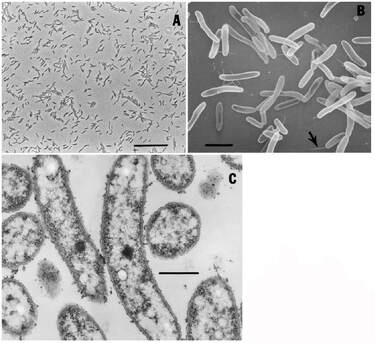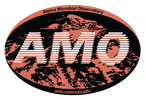|
by Ylenia Vimercati Molano The genus Rhodoferax in the Comamonadaceae family comprises purple nonsulfur bacteria adapted to cold and extreme environments such as Antarctica, where the species Rhodoferax antarcticus has been isolated (Figure 1). This anoxygenic phototrophic bacterium is a psychrotrophic species (an organism capable of surviving or thriving in extremely cold environments) growing optimally at 12-18°C with a growing temperature range between 0 and 25°C (Madigan et al. 2000).  Figure 1. Morphology of cells of strain ANT.BR. (Rhodoferax antarcticus). A) Phase-contrast photomicrograph (bar 10 mm). B) Scanning electron micrograph (bar 2 mm); arrow points to possible polar flagellum. C) Transmission electron micrograph (bar 0.5 mm). Note absence of obvious intracytoplasmic membranes. From Madigan et al. 2000. Studies have reported the presence of two strains of Rhodoferax antarcticus from algal-bacterial mat samples in the Antarctica Dry Valleys as well as from limnological studies in the Vestfold Hills of East Antarctica (Jung et al. 2004). Furthermore, an ongoing project led by AMO’s Lara Vimercati at Palmer Station, Antarctica, has found a high concentration of this genus early in the chronosequence of Anvers Island’s retreating glacier. Glacial retreat in Antarctica due to climate change is a huge phenomenon and microbiologists are focused on studying the ecological succession of microorganisms along the exposed soils. According to the project, Rhodoferax is one of the most common genera in youngest, most recently deglaciated soils. The Comamonadaceae family has been observed to be dominant in stages of primary succession elsewhere too, while its abundance decreased in intermediate age soils and was absent in the oldest ones (Liu et al. 2011). We are finding this same scenario in the Palmer chronosequence, with Rhodoferax being abundant at 0 m from the glacier terminus where species richness recorded for bacteria is the lowest.
Initial stages of a glacier forefield are characterized by nitrogen and carbon deficiency (Liu et al. 2011), which makes exposed soils ideal for extreme microorganisms like Rhodoferax to colonize. As an example, Rhodoferax antarcticus can grow phototrophically (anaerobically), both photoautotrophically using hydrogen and photoheterotrophically using a variety of substrates, as well as chemoorganitrophically (aerobically in the dark) (Madigan et al. 2000). References: Jung DO, Achenbach LA, Karr EA, Takaichi S, Madigan MT. (2004). A gas vesiculate planktonic strain of the purple non-sulfur bacterium Rhodoferax antarcticus isolated from Lake Fryxell, Dry Valleys, Antarctica. Archives of Microbiol, Springer 182 :236–243 Liu G, Hu P, Zhang W, Wu X, Yang X, Chen T, Zhang M, Li S. (2011). Variations in soil culturable bacteria communities and biochemical characteristics in the Dongkemadi glacier forefield along a chronosequence. Folia Microbiol 57:485–494 Madigan MT, Jung DO, Woese CR, Achenbach LA. (2000). Rhodoferax antarcticus sp. nov., a moderately psychrophilic purple nonsulfur bacterium isolated from an Antarctic microbial mat. Archives of Microbiol, Springer 173 :269–277
0 Comments
|
AuthorVarious lab members contribute to the MoM Blog Archives
October 2023
Categories |

 RSS Feed
RSS Feed
